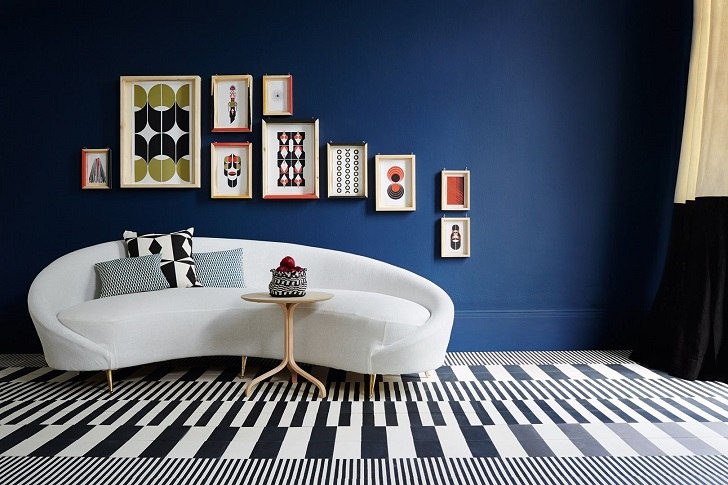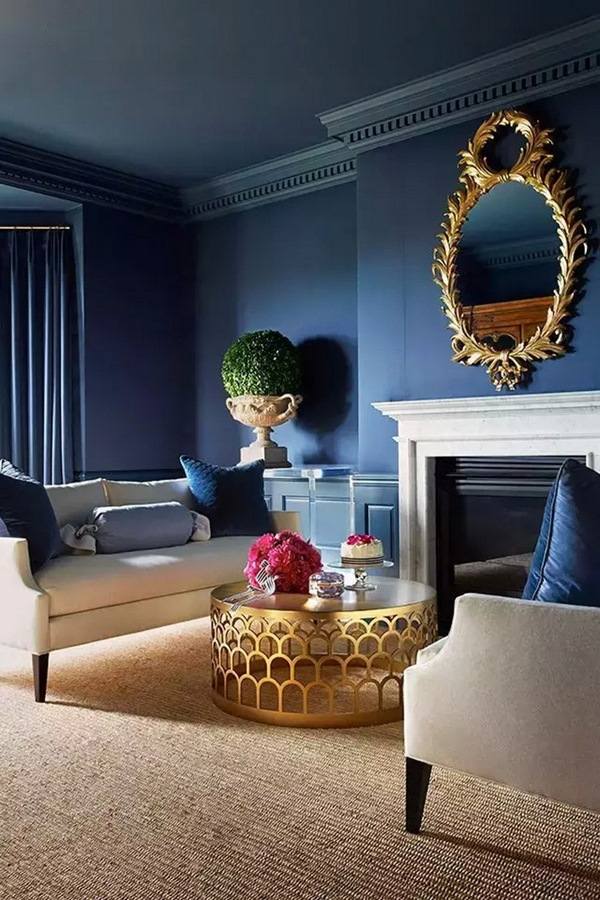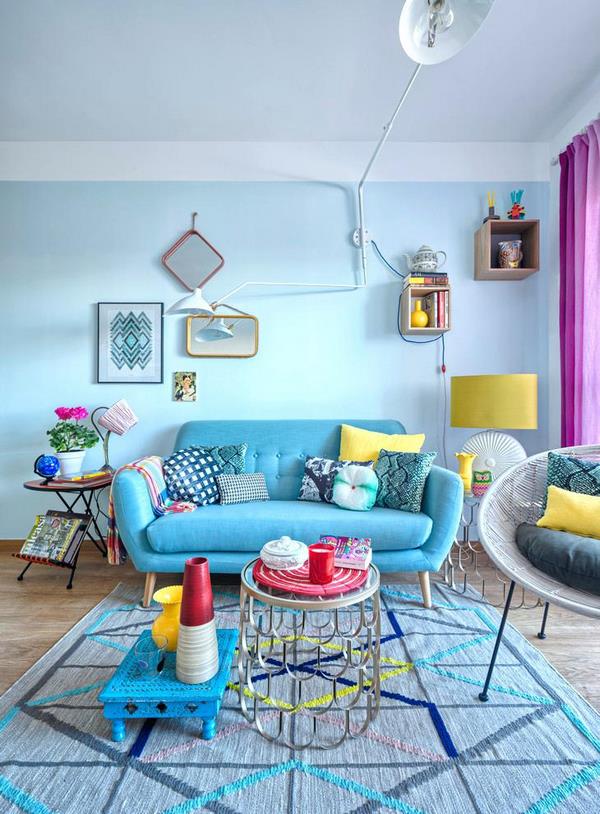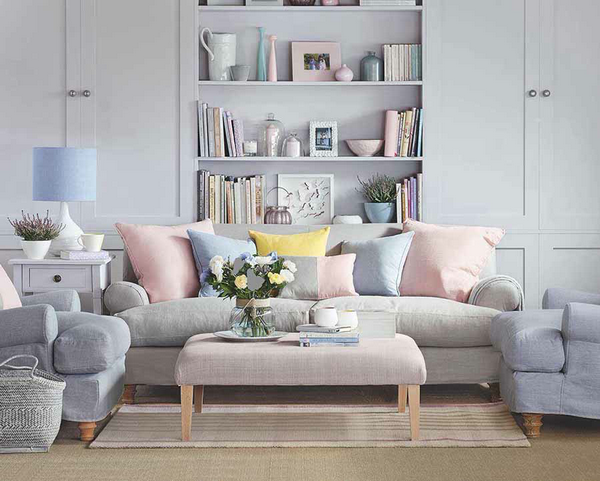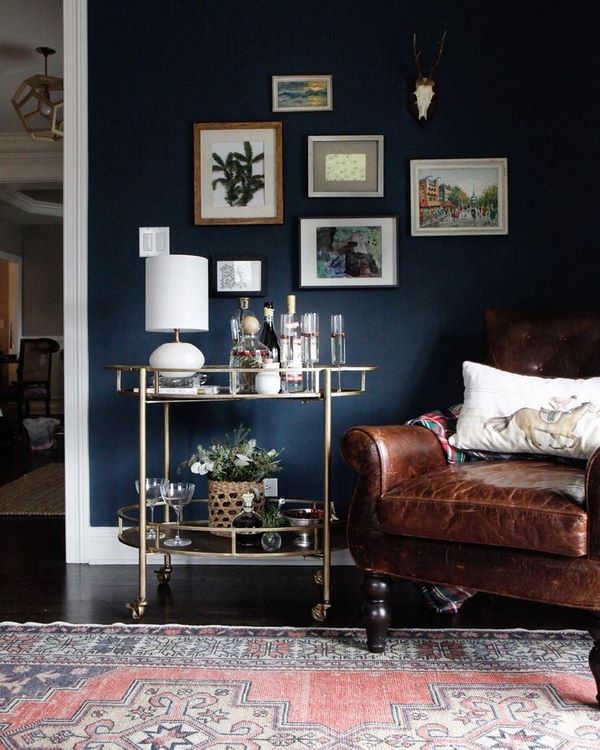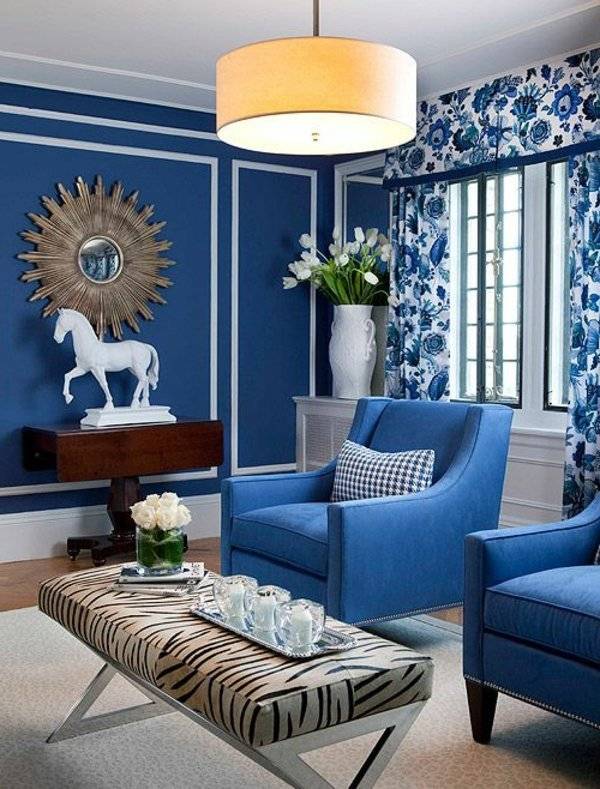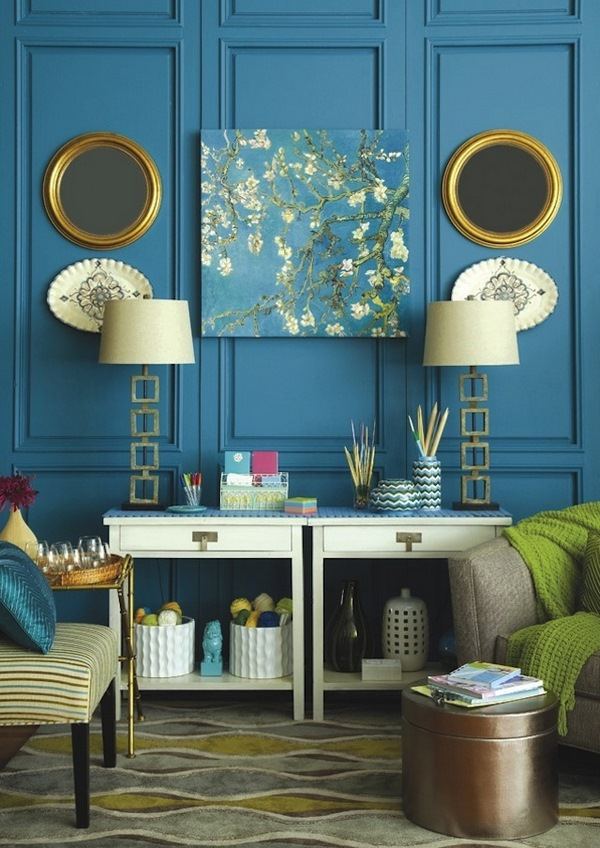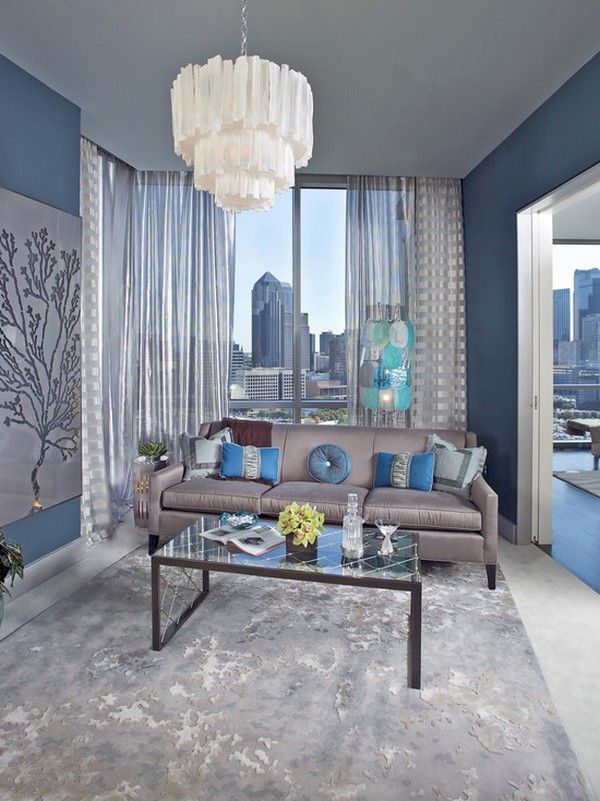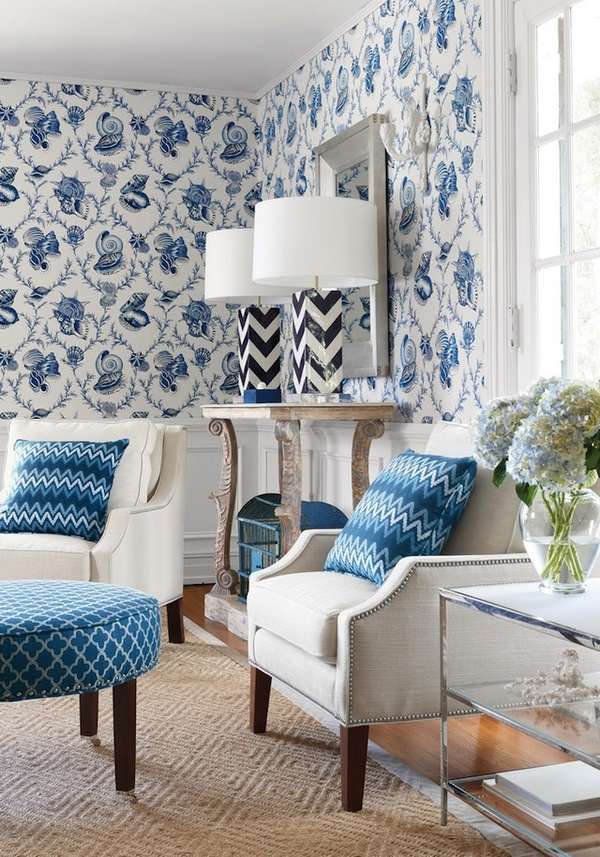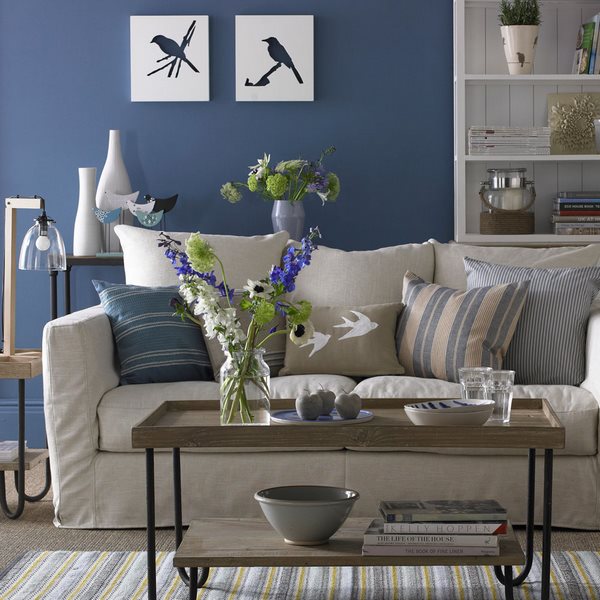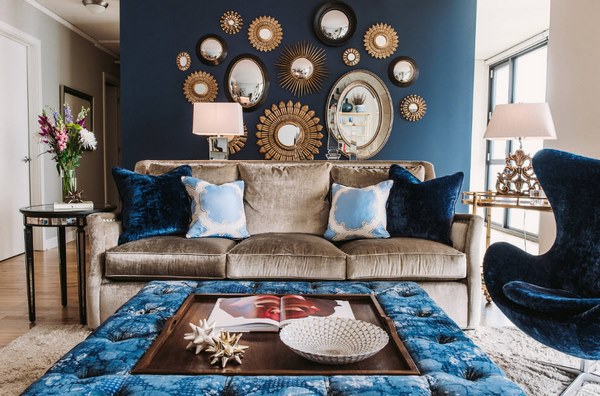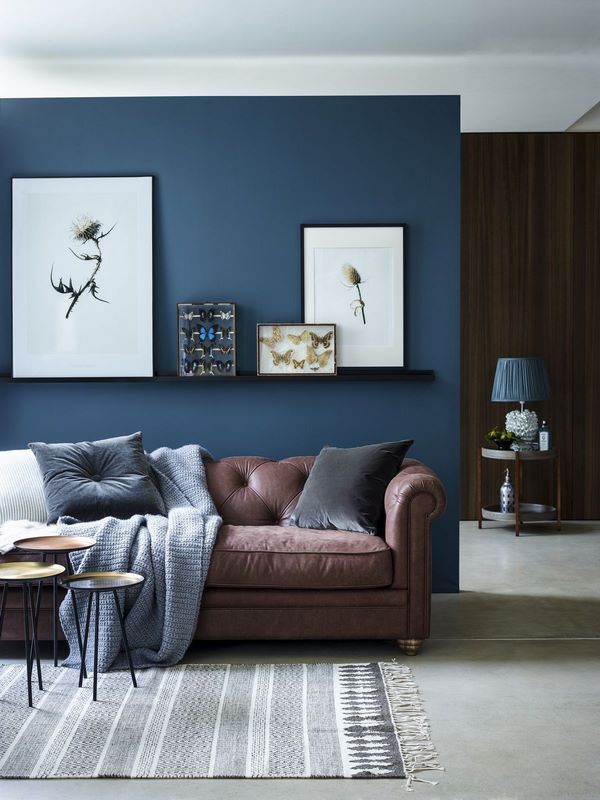Blue living room can be the highlight of the home although it is not the first choice of homeowners when they select the color scheme for the interior as it is classified as a cold shade. However, the color has so many beautiful shades, darker and lighter, that an experienced designer can easily create a relaxing and comfortable room which will help to remove the everyday stress.
Blue is widely popular in beach themed interiors as it combines practicality and functionality. The wide variety of shades – from deep dark ones to soft pastels – create comfort in large rooms and remind of the sea. We have selected some beautiful examples in different styles to show you how to use this color in the design of your living room.
Blue color is able to create a sense of spaciousness, freshness, cleanliness and tranquility even in a very limited space, it improves mood and evokes positive emotions. Even the richest dark shades look great when complemented with a few contrasting warm shades and those who are afraid that their living space will look dark and strict should select the right accents to create a vibrant and vivid atmosphere. Blue is a symbol of comfort, safety, aristocracy and loyalty. Using rich shades in the interior should be carefully thought out. Blue tones love sun and natural light and you can safely use them in rooms with windows facing south, south-east or south-west. The color will look cold in shady rooms that are not illuminated by direct sunlight and rooms with windows facing north.
What is the best style for a blue living room and how to use it?
Creating the interior of a living room is a responsible task, because this is the area of the home where the family gathers every day, it accommodates guests so besides the comfortable furniture and expressive accessories, it should have the right atmosphere, which is created by color combinations.
Blue is a color of nature and is always pleasant to the eye. Designers are well aware of this and use these shades when creating decors in different styles. This spectrum pleases with a variety of shades. Each shade of the palette pleases with its qualities. Turquoise, indigo and the colors of the sea are particularly interesting and working with them is a pleasure even for beginners and DIY lovers. A pastel shade, for example, is a wonderful background that emphasizes the beauty of the room and dark accessories. However, dark decors are a very rare phenomenon and when it comes to deep and rich shades, it is better to consult with professionals in order to avoid a gloomy atmosphere in the room.
So, what is the best style for a blue living room? The answer to this question is that you can choose from many styles as most of them allow the use of blue. You can introduce it as a main color or restrict it to a few accessories or furniture items – a sofa, an armchair, vases, figurines, etc. Here are some ideas:
Marine-style living room is complemented by red shades – without them the interior may appear monotonous and boring. If the room is not decorated in this style you can use any additional colors like green, orange, etc.
Traditional style living rooms also look great in blue, usually in shades from the richer side of the spectrum, as it gives them an atmosphere of stability and respectability.
If you want a Mediterranean interior you can choose between its fabulous varieties – Moroccan, Oriental, Greek, Italian, as the blue color is widely used. It is one of the main colors in Arabic interiors and can be seen in a huge number of details as well.
Blue looks exceptionally solemn version in Art Deco or Empire style and is the best way to express refinement, beauty and pomposity.
Bright shades are typical for living rooms with pop art decoration, metallic – grayish shades are a good choice for hi-tech interiors while Bohemian chic style allows you to use the color in original and unexpected shades and combinations.
A tropical interior easily combines blue with pink, yellow, turquoise and orange.
How to use blue color in the interior of living rooms? There are many ways and you can choose it as a main or as an accent color, you can combine several shades, etc. We shall look at some of the options and give you useful tips.
Blue walls – Many people think that this option is not appropriate as the interior of the living room looks cold, dark and smaller. However, this is completely wrong – if there is good artificial or natural lighting, the design will be spectacular, very stylish and elegant. Those who are afraid to use the color as a wall paint can use it on an accent wall which is an immediate strong and bold statement.
The blue living room, as mentioned earlier, should be chic and, at the same time, harmonious. The ceiling can be decorated a light shadewith chandeliers or pendant light fixtures and spotlights around the perimeter.
One of the general rules for upholstered furniture in a blue interior – a sofa, armchairs, upholstered chairs – is that furniture should have a color that stands out in the interior. For contemporary interiors you can choose furniture in contrasting colors with monochrome or combined glossy facades, glass and metal while natural wood shades are welcome for traditional interiors. Bright furniture pieces look beautiful against a background of pale blue or turquoise walls. To balance the interior you can use carpet, area rugs, decorative pillows, vases or other accessories. Turquoise chairs, for example, are eye-catching and a bold, but elegant solution. Milky white, beige, sand, all shades of brown, green, white or orange furniture pieces add a touch of coziness and warmth to the living room – a sofa, a coffee table, floor lamps, ottomans, etc.
Accessories – if you want to add a limited amount of blue color to the interior of the living room, you can choose accessories like curtains, photo frames, sofa cushions, area rugs, candles, etc.
Blue living room – ideas for successful color combinations
Monochromatic living room will look elegant, but too strict. Additional colors will help you create a stylish, spectacular interior and there are several time tested combinations.
Blue – white is one of the most popular color combinations not only among designers but among homeowners as well. The great popularity of this combination is due to the fact that it immediately solves two problems. The first is that white color helps visually increase the space and the second – the blue brings freshness into the room. This combination is ideal for small rooms. Blue walls will look instantly better with snow-white curtains, a cozy leather sofa and a fluffy carpet on the floor. White and blue wallpaper with a floral pattern is the perfect choice to add a touch of romance in a vintage and Shabby chic styled living rooms while geometric and abstract patterns are a great choice for contemporary interiors.
Gray is one of the trendiest colors and when combined with blue creates a quiet, cozy atmosphere and sophisticated design. When you choose to use only those two colors you need to observe their balance. Soft yellows, lilac, purples, peach, orange, sandy shades or white are good accents. You can use them for curtains, cushions, carpet, ceramic ornaments, etc.
Beige shades and blue create a warm, gentle combination. Blue is the color of the sky and the sea. Including additional shades gives the overall design character and depth. This combination is just as popular for beach and coastal interior designs as blue and white, since the beige reminds of the beach and sand but it looks softer and more casual. The combination works well for contemporary interiors and expresses power and confidence, for example, a light wallpaper as a background of chocolate brown sofa and textiles in beige tones.
Sunny yellow shades are naturally combined with blue as they remind of a beautiful summer day and this is the perfect harmony of contrasting colors. A living room interior in these tones will certainly raise the mood and make you smile. The more saturated the yellow, the brighter the blue neighbor should be. This combination is most often emphasized by additional neutral shades which soften the cold/warm contrast. Most often it is white, but you can also use pink and green, gray and brown, etc.
Blue and green are placed side by side on the color wheel and are naturally related colors. They are often called “similar” and in interior design they can be used to create magnificent, lively and harmonious atmosphere. Both are associated with nature – green represents the earth, grass, fresh tree leaves and blue represents the sky. What could be better in one room?
Blue and brown – being a truly natural color, blue is beautifully emphasized by browns which are associated with wood. The neutral character of the brown palette balances the intensity of blue and softens its coldness. Rich shades like dark walnut, cherry, chestnut, teak, mahogany, dark oak are a guarantee that you will have a noble and elegant interior. However, you need to take into account the lighting in the living room if you have chosen this combination. In small rooms with a limited amount of natural light it is better to use the lighter tones of both palettes because intensive tones will make the space appear even smaller and narrower.
Blue and red can be an explosive combination as these are two very strong opposite colors. Red is bright, bold, vivid, active and blue is calm, cold, sometimes strict. The best way to soften the antagonism of these two colors is to add white which balances their strength and takes out the best properties of both.
Blue and orange is another bright, bold and eye-catching combination. Orange is extremely expressive and a contrast to the cold blue. Again, white creates a balance between the energies of these strong tones.
Last, but not least, let’s look how silver and gold combine with blue. A living room with gold shades looks rich, expensive, sophisticated and exceptionally classy. It is a statement of prosperity and luxury. Silver is cooler, elegant and a good choice for contemporary interiors where the stainless steel sheen adds to the modern atmosphere. Both should be used moderately in modern living room design, unless you create an interior in Baroque or Empire style, as their role is to make blue more noble and the excessive use is accepted as bad taste.
As we said in the beginning, blue comes in numerous shades – indigo, turquoise, pastel blue, sky blue, denim, azure, cobalt, sapphire, etc. – and each one of them is unique in its own way. When you want to decorate your living room in blue it is best to consult a professional designer if your choice tends to deep and darker shades. Otherwise, the best option is to keep to pastel and light shades and never forget about balance.

